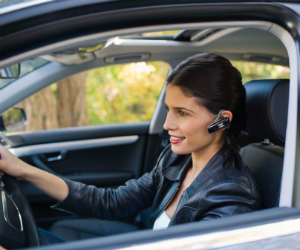Why Hands-Free Phones Are A Driving Danger
 By now, we should all know that talking on a cell phone while driving is a bad idea. So far, 14 states have banned driving with a handheld phone, but researchers caution that hands-free phones may be just as dangerous and distracting.
By now, we should all know that talking on a cell phone while driving is a bad idea. So far, 14 states have banned driving with a handheld phone, but researchers caution that hands-free phones may be just as dangerous and distracting.
In 2011 the National Transportation Safety Board called for an end to all cellphone use in the car saying, “there is no difference between hand-helds and hands-free.” New research from a team of psychological scientists from Carleton University in Ottawa, Canada further confirms that even hands-free phone conversations can have a negative impact on driver performance.
In order to drive safely, we need to be able to accurately assess what’s going on around us in space and time—also known as situational awareness. Situational awareness allows drivers to organize the sights and sounds around them into a comprehensible mental representation that can then be used to anticipate what might happen on the road. Previous research has found that when drivers are chatting on the phone, they seem to have diminished situational awareness and more difficulty noticing changes in their speed and the location of other cars.
Researchers Adam Heenan, Chris M. Herdman, Matthew S. Brown, and Nicole Robert hypothesized that the cognitive mechanisms used in keeping up with a conversation are also essential for visualizing where the car is in space and how fast it’s going. Essentially, yakking on the phone is dangerous in the car because following along with a conversation competes for the same cognitive resources drivers rely on to assess what’s happening on the road.
For the study, 28 participants were recruited to complete a scenario in a driving simulator. As a stand-in for a phone conversation, researchers had the participants play the game 20-questions. In 20-questions one player comes up with an item (a person, place, thing, food, or animal) that the other player must guess using no more than 20 yes-or-no questions.
In one experiment, participants drove through an “easy” course simulating a rural area with no traffic, intersections, or obstacles. In a second experiment, participants drove through a more challenging course where they had to contend with other drivers and variations in traffic.
As expected, when the participants were playing 20-questions, particularly when they were the ones asking the questions, they had more trouble on the road. They were more likely to speed and misremember important details, like how far away the other cars were and how much traffic was on the road.
These findings support the hypothesis that talking on the phone, even a hands-free one, competes for the cognitive resources that drivers need to maintain situational awareness.
“In the present research, engaging in conversation impaired drivers’ ability to estimate the distance between their car and vehicles in the rear and made them more likely to believe that vehicles were in a different lane while missing others entirely,” the researchers write in Human Factors: The Journal of the Human Factors and Ergonomics Society. “Such driving performance outcomes could have obvious real-world repercussions.”
Reference
Heenan, A., Herdman, C. M., Brown, M.S., Robert, N. (2014). Effects of Conversation on Situation Awareness and Working Memory in Simulated Driving. Human Factors: The Journal of the Human Factors and Ergonomics Society, 56(6), 1077-1092. DOI: 10.1177/0018720813519265





APS regularly opens certain online articles for discussion on our website. Effective February 2021, you must be a logged-in APS member to post comments. By posting a comment, you agree to our Community Guidelines and the display of your profile information, including your name and affiliation. Any opinions, findings, conclusions, or recommendations present in article comments are those of the writers and do not necessarily reflect the views of APS or the article’s author. For more information, please see our Community Guidelines.
Please login with your APS account to comment.